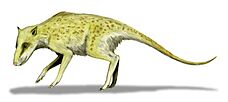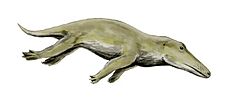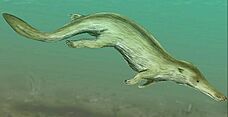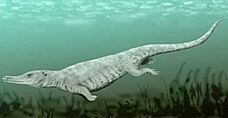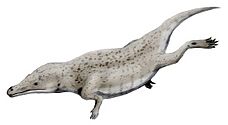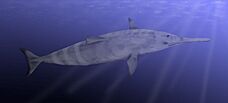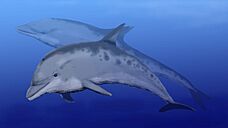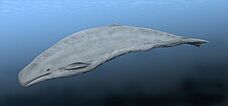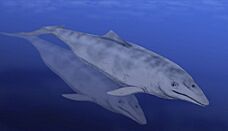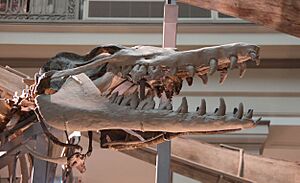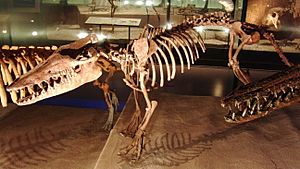Evolution of cetaceans facts for kids

The story of how whales evolved is a fascinating journey from land to sea. It began about 50 million years ago on the Indian subcontinent. Whales, dolphins, and porpoises are all part of a group of aquatic mammals called cetaceans. Believe it or not, their ancestors were hoofed animals that walked on land, and their closest living relative today is the hippopotamus. This amazing transformation took at least 15 million years.
Like other mammals, cetaceans need to come to the surface to breathe air. They also nurse their young with milk. Even though they live in the water, their skeletons still have clues from their land-dwelling past, like the bone structure in their flippers, which looks like a hand with five fingers. Discoveries in Pakistan have helped scientists piece together the amazing story of how these animals returned to the ocean.
Modern cetaceans are divided into two main groups. The Mysticeti (baleen whales) and the Odontoceti (toothed whales) went their separate ways about 30 million years ago. Toothed whales developed a special skill called animal echolocation, which is like a natural sonar. Baleen whales lost their teeth and instead grew huge filtering plates called baleen to eat tiny creatures in the water.
The First Whales
The earliest whales are called Archaeoceti, which means "ancient whales." They show the step-by-step changes from a land animal to an ocean dweller.
For a long time, scientists thought whales were related to an extinct group of wolf-like carnivores called mesonychians because of their similar teeth. But DNA studies showed something surprising: whales' closest living relatives are actually hippopotamuses!
This means that the ancestors of whales were part of the group called Artiodactyla, or even-toed hoofed animals. The discovery of early whale fossils, like Pakicetus, confirmed this. These ancient whales still had some features from their ancestors, but they were clearly on the path to living in the water. While other hoofed animals became plant-eaters, whales remained carnivores, hunting for fish and other animals in their new aquatic home.
Indohyus: A Clue from the Forest Floor
About 48 million years ago, an animal called Indohyus lived in what is now Kashmir. It was small, about the size of a house cat, and looked like a tiny deer. Indohyus is very important because it is thought to be one of the closest relatives to the first whales.
It had a special, thick, and dense ear bone called an involucrum. This feature is the main clue that identifies an animal as a cetacean, and Indohyus is the only known land animal to have it. Its bones were also very dense, which would have helped it stay underwater, much like a modern hippo. Scientists think that when it was scared, Indohyus might have jumped into the water and hidden at the bottom, just like the water chevrotain in Africa does today.
Pakicetidae: The Wading Whales
The pakicetids are considered the first true cetaceans. They lived around 50 million years ago. Fossils show they were hoofed animals that looked a bit like wolves. They lived near rivers in a dry environment.
Pakicetids are classified as whales because their skulls and ear bones have the special shape unique to cetaceans. However, they didn't have a blowhole yet, and their ears were still built for hearing on land. Their eyes were on the top of their heads, like a crocodile's, which would have helped them see above the water while their body was submerged. Their leg bones suggest they were not great swimmers but were probably good at wading in shallow water.
Ambulocetidae: The Walking and Swimming Whale
Ambulocetus, which means "walking whale," lived about 49 million years ago. It was a fearsome predator that looked like a furry crocodile. It could walk on land, but its short legs made it clumsy. In the water, it was a powerful swimmer.
Ambulocetus likely swam by kicking its large back feet and moving its tail up and down, similar to an otter. It lived in coastal waters and could drink both fresh and salt water. This shows it was a transitional animal, comfortable in both land and sea environments.
Protocetidae: The First World Travelers
The protocetids were a diverse group of early whales that lived between 48 and 35 million years ago. They were the first whales to leave the Indian subcontinent and spread across the world's oceans.
Some protocetids could still walk on land, while others were more adapted to the water. A famous fossil of a pregnant Maiacetus shows the baby was positioned to be born head-first. This suggests that Maiacetus had to come ashore to give birth, as baby whales today are born tail-first to avoid drowning. Some protocetids, like Rodhocetus, had developed powerful tails and may have had the beginnings of a tail fluke.
Basilosauridae: The First Kings of the Ocean
By about 40 million years ago, whales like Basilosaurus and Dorudon were fully aquatic. They lived their entire lives in the ocean and could not come onto land. Basilosaurus was enormous, reaching lengths of up to 18 meters (60 feet)!
These whales looked much more like modern whales. They had a streamlined body, flippers for steering, and a powerful tail with a fluke for swimming. Their nostrils had moved farther up their snout, getting closer to the blowhole position of modern whales.
One of the most interesting things about basilosaurids is that they still had tiny, visible hind legs! These legs were far too small for walking and were probably used to help during reproduction. These leftover legs are clear evidence that whales evolved from ancestors that walked on land.
The Rise of Modern Whales
Baleen Whales: The Gentle Giants
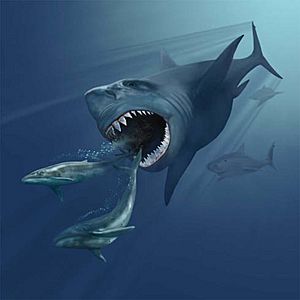
Modern baleen whales, or mysticetes, are the largest animals on Earth. Instead of teeth, they have huge plates of baleen hanging from their upper jaws. They use these plates like a giant sieve to filter huge amounts of tiny animals, like krill, from the water.
The earliest baleen whales, like Janjucetus, actually had both teeth and baleen. Over time, the teeth disappeared, and baleen became the main way of feeding. This new way of eating was very efficient and allowed these whales to grow to enormous sizes.
Toothed Whales: Masters of Echolocation
The other group of modern whales is the toothed whales, or odontocetes. This group includes dolphins, porpoises, and sperm whales. Their most important adaptation is echolocation.
Echolocation is like a natural sonar. The whale makes a series of clicking sounds that travel through the water. When the sounds hit an object, like a fish, the echoes bounce back. The whale listens to these echoes through its lower jaw, which helps it "see" its surroundings and hunt for food, even in complete darkness. This ability allowed toothed whales to hunt in deep water where there is no light.
How Whale Skeletons Changed
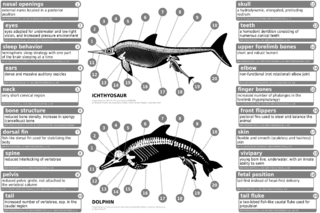
The journey from land to sea involved many changes to the whale skeleton.
- Legs to Flippers: Front legs became shorter and flatter, turning into flippers used for steering.
- Disappearing Hind Legs: Back legs shrank over millions of years. Today, modern whales only have tiny, hidden hip and leg bones inside their bodies. These bones serve no purpose for movement but are a powerful reminder of their four-legged past.
- A Traveling Nose: The nostrils of the earliest whales were at the tip of the snout. Over time, they slowly moved to the top of the head to become the blowhole. This allows a whale to breathe easily without having to lift its whole head out of the water.
- Underwater Hearing: Hearing in water is very different from hearing in air. The ear bones of whales changed to pick up vibrations that travel through the water and their jawbone.
The pelvic bones, or hip bones, also changed dramatically. In land animals, the pelvis connects the hind legs to the spine. In early whales like Pakicetus, the pelvis was still strong. But as whales became fully aquatic and their hind legs disappeared, the pelvis became disconnected from the spine and shrank. In modern whales, the small pelvic bones that remain are thought to help support muscles used in reproduction.
See also
 In Spanish: Evolución de los cetáceos para niños
In Spanish: Evolución de los cetáceos para niños
- Aquatic adaptation
- Evolution of mammals
- Evolution of sirenians
- List of extinct cetaceans
- Transitional form



